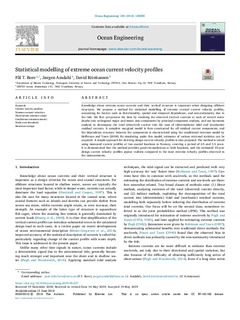| dc.contributor.author | Bore, Pål Takle | |
| dc.contributor.author | Amdahl, Jørgen | |
| dc.contributor.author | Kristiansen, David | |
| dc.date.accessioned | 2019-09-24T08:51:24Z | |
| dc.date.available | 2019-09-24T08:51:24Z | |
| dc.date.created | 2019-09-12T20:44:46Z | |
| dc.date.issued | 2019-08-15 | |
| dc.identifier.citation | Ocean Engineering. 2019, 186:106055 1-22. | nb_NO |
| dc.identifier.issn | 0029-8018 | |
| dc.identifier.uri | http://hdl.handle.net/11250/2618405 | |
| dc.description.abstract | Knowledge about extreme ocean currents and their vertical structure is important when designing offshore structures. We propose a method for statistical modelling of extreme vertical current velocity profiles, accounting for factors such as directionality, spatial and temporal dependence, and non-stationarity due to the tide. We first pre-process the data by resolving the observed (vector) currents at each of several water depths into orthogonal major and minor axis components by principal component analysis, and use harmonic analysis to decompose the total (observed) current into the sum of (deterministic) tidal and (stochastic) residual currents. A complete marginal model is then constructed for all residual current components, and the dependence structure between the components is characterized using the conditional extremes model by Heffernan and Tawn (2004). By simulating under this model, estimates of various extremal statistics can be acquired. A simple approach for deriving design current velocity profiles is also proposed. The method is tested using measured current profiles at two coastal locations in Norway, covering a period of 2.5 and 1.5 years. It is demonstrated that the method provides good extrapolations at both locations, and the estimated 10-year design current velocity profiles appear realistic compared to the most extreme velocity profiles observed in the measurements. | nb_NO |
| dc.language.iso | eng | nb_NO |
| dc.publisher | Elsevier | nb_NO |
| dc.rights | Attribution-NonCommercial-NoDerivatives 4.0 Internasjonal | * |
| dc.rights.uri | http://creativecommons.org/licenses/by-nc-nd/4.0/deed.no | * |
| dc.subject | Current velocity profiles | nb_NO |
| dc.subject | Extreme current velocities | nb_NO |
| dc.subject | Multivariate extreme values | nb_NO |
| dc.subject | Conditional extremes model | nb_NO |
| dc.subject | Peaks over threshold | nb_NO |
| dc.subject | Structural design | nb_NO |
| dc.title | Statistical modelling of extreme ocean current velocity profiles | nb_NO |
| dc.type | Journal article | nb_NO |
| dc.type | Peer reviewed | nb_NO |
| dc.description.version | publishedVersion | nb_NO |
| dc.rights.holder | © 2019 The Authors. Published by Elsevier Ltd. This is an open access article under the CC BY-NC-ND license | nb_NO |
| dc.source.pagenumber | 1-22 | nb_NO |
| dc.source.volume | 186:106055 | nb_NO |
| dc.source.journal | Ocean Engineering | nb_NO |
| dc.identifier.doi | 10.1016/j.oceaneng.2019.05.037 | |
| dc.identifier.cristin | 1724230 | |
| cristin.unitcode | 7566,2,0,0 | |
| cristin.unitname | Sjømatteknologi | |
| cristin.ispublished | true | |
| cristin.fulltext | original | |
| cristin.qualitycode | 1 | |

